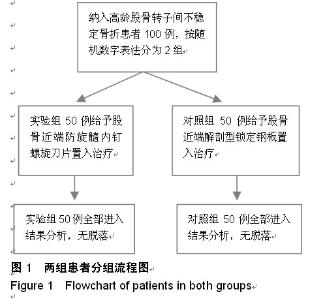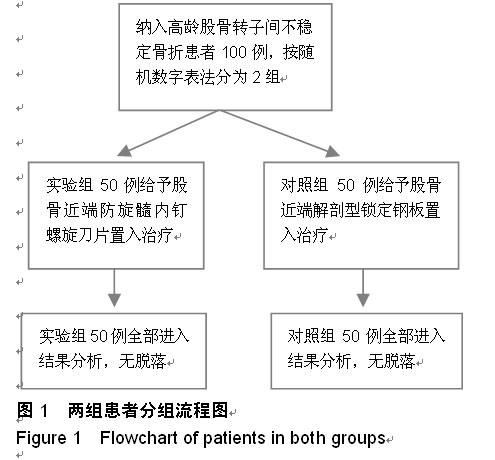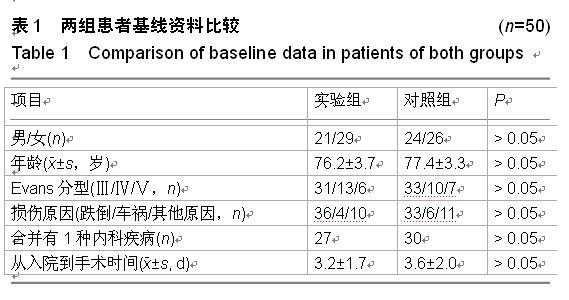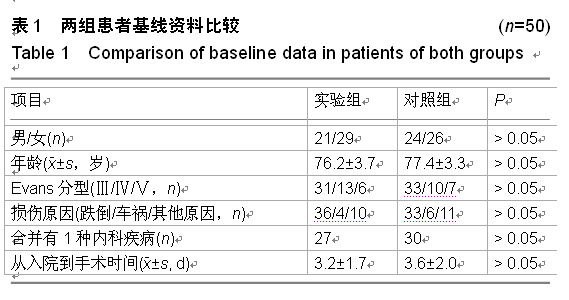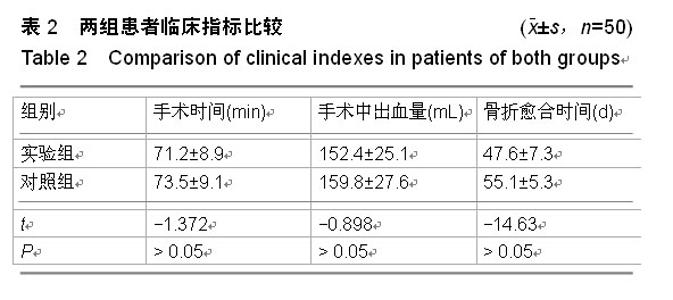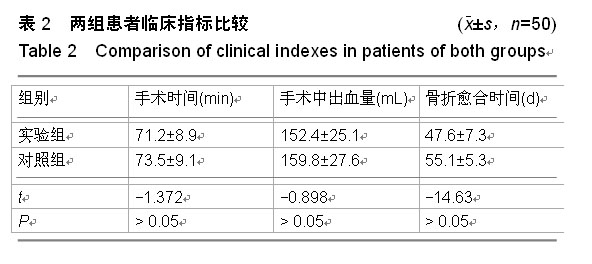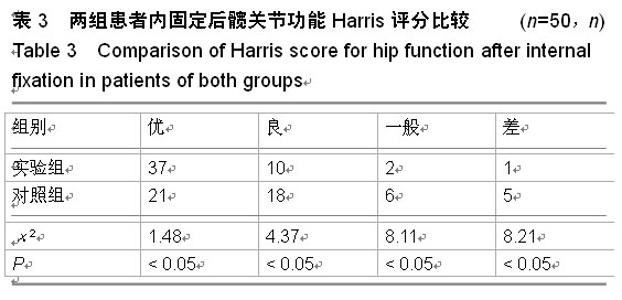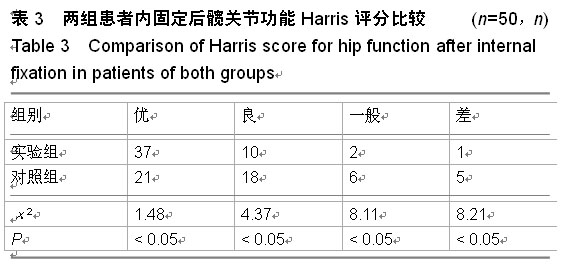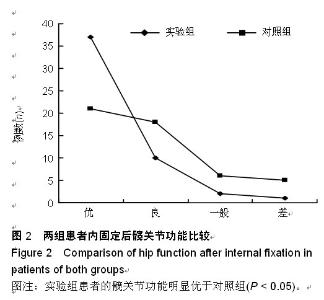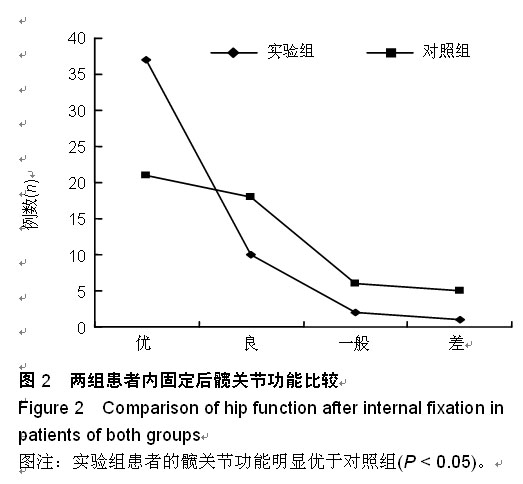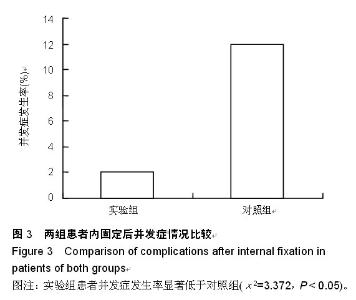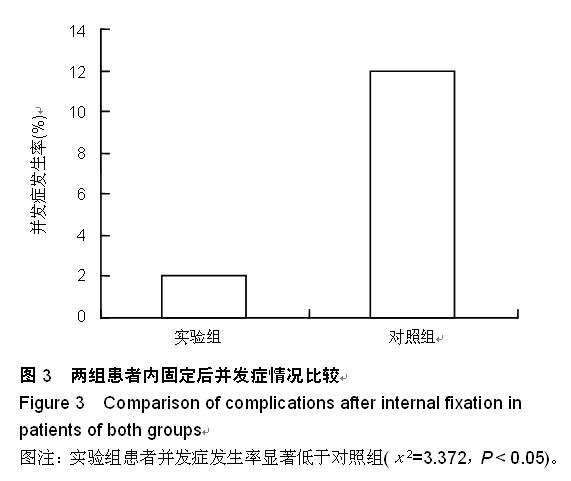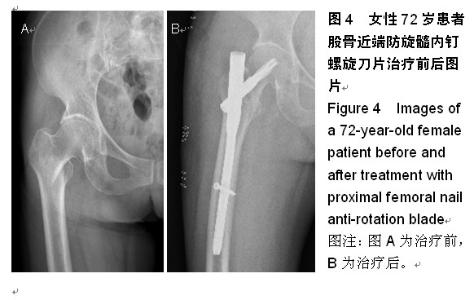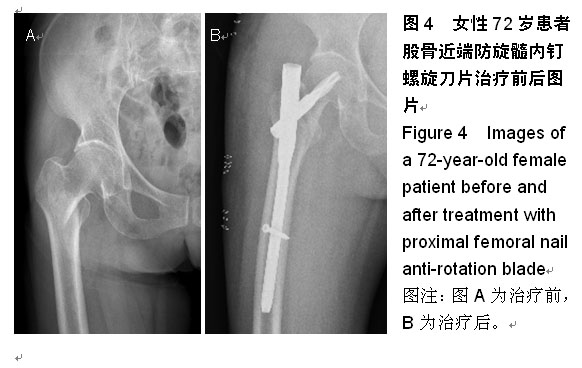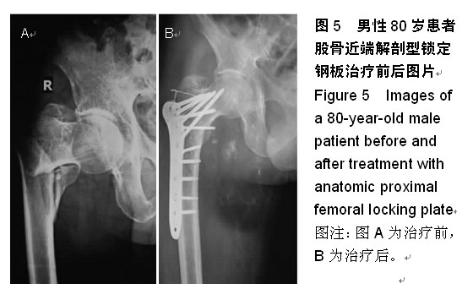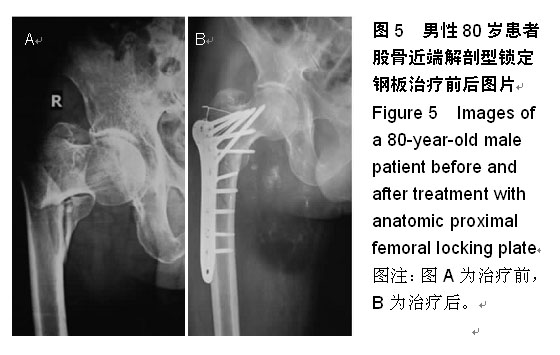Chinese Journal of Tissue Engineering Research ›› 2015, Vol. 19 ›› Issue (22): 3550-3554.doi: 10.3969/j.issn.2095-4344.2015.22.020
Previous Articles Next Articles
Nail anti-rotation blade versus locking plate for the repair of elderly unstable intertrochanteric fractures: hip function
Wu Han, Zhang Jian, Li Qiang, Yuan Qi
- Department of Orthopedics, Youyi Branch, Kunshan First People’s Hospital, Kunshan 215300, Jiangsu Province, China
-
Received:2015-04-01Online:2015-05-28Published:2015-05-28 -
About author:Wu Han, Associate chief physician, Department of Orthopedics, Youyi Branch, Kunshan First People’s Hospital, Kunshan 215300, Jiangsu Province, China
CLC Number:
Cite this article
Wu Han, Zhang Jian, Li Qiang, Yuan Qi. Nail anti-rotation blade versus locking plate for the repair of elderly unstable intertrochanteric fractures: hip function [J]. Chinese Journal of Tissue Engineering Research, 2015, 19(22): 3550-3554.
share this article
| [1] Zhang PX, Xue F, Dang Y, et al.Clinical effect of distal radius fracture treated with open reduction and internal plate fixation. Chin Med J (Engl). 2012;125(1):140-143. [2] 王鹏建,丁宇,阮狄克,等.不稳定股骨转子间骨折的内固定选择及术后并发症原因分析[J].临床骨科杂志,2010,13(4):391-393. [3] 张小刚,郭岩凤,王西林.采用股骨近端螺旋刀片髓内钉治疗老年人股骨粗隆间骨折疗效观察[J].中国基层医药,2012,19(3): 428-429. [4] 恽常军,钱文杰,吴俊义,等.抗旋股骨近端髓内针治疗老年人股骨转子间骨折[J].临床骨科杂志,2010,13(3):309-310. [5] Ye TW, Chen AM. Stress fracture of the clavicle secondary to coracoclavicular fixation using a multistrand titanium cable: a case report. Chin Med J (Engl). 2010;123(21):3157-3159. [6] Yan L,Guo H,Zheng W, et al. KumaFix fixation for thoracolumbar burst fractures: a prospective study on selective consecutive patients. Chin Med J (Engl). 2014; 127(11):2001-2006. [7] 吴立军,杨峰,张振清.防旋股骨近端髓内钉治疗老年人股骨转子间骨折[J].临床骨折杂志,2012,15(4):467. [8] 徐卫东,张凯.两种不同方法治疗老年人股骨粗隆间骨折疗效及对髋关节功能影响比较[J].中国基层医药,2014,1(10): 1468-1469. [9] 朱振宏.股骨近端抗旋转髓内钉在老年人股骨粗隆间骨折治疗中的应用[J].中国基层医药,2013,20(17):2613-2615. [10] 毛琦,龚志锋,蓝子江,等.股骨近端防旋髓内钉与动力髋螺钉治疗老年人股骨粗隆间骨折的疗效比较[J].中国基层医药,2013,20(1): 44-46. [11] Dawei T, Na L, Jun L, et al. A novel fixation system for sacroiliac dislocation fracture: Internal fixation system design and biomechanics analysis. Clin Biomech. 2013;28(2): 129-133. [12] Wong LC, Chiu WK, Russ M, et al. Review of techniques for monitoring the healing fracture of bones for implementation in an internally fixated pelvis. Med Eng Phys. 2012;34(2):140-152. [13] Chen G, Schmutz B, Wullschleger M, et al. Computational investigations of mechanical failures of internal plate fixation. J Eng Med. 2010;224(1):119-126. [14] 梁博伟,赵劲民,殷国前,等.经皮微创钢板固定治疗胫骨下段骨折:与髓内钉固定和切开复位钢板内固定的比较[J].中国组织工程研究,2012,16(17):3116-3120. [15] 胡卫国,罗永湘,方煌,等.不稳定股骨转子间骨折不同内固定方法疗效比较[J].中国修复重建外科杂志,2006,20(7):690-694. [16] 杨晓东.动力髋螺钉与股骨近端带锁髓内钉治疗股骨转子间骨折的效果比较[J].中国基层医药,2013,20(17):2626-2628. [17] 刘艳辉,刘俊国,刘艳玲,等.两种微创方法治疗股骨转子间不稳定型骨折疗效比较[J].中国医师进修杂志,2012,35(32):36-38. [18] 魏俊强,刘利蕊,潘进社,等.仰卧位与侧卧位闭合复位髓内钉固定治疗股骨干骨折的疗效比较[J].中华创伤骨科杂志,2013,15(8):660-665. [19] Ozlem G, Dilek OE, Serhat O, et al. Treatment of a distal radius and ulna fracture in a young llama with a combination of external and internal fixation. Turk Veterinerlik Hayvancilik Dergis. 2013;37(1):125-128. [20] 付世杰,高海军,张建志,等.股骨干骨折闭合复位髓内钉固定术中大转子倾斜指数的应用[J].中华创伤骨科杂志,2013,15(5): 411-415. [21] 李明辉,彭昊,刘洋.亚洲型股骨近端防旋髓内钉治疗老年股骨粗隆间骨折的临床疗效[J].中华老年医学杂志,2013,32(7): 757-760. [22] Coates C, Goeser P, Coates-Clark C, et al. Impact Response and Simulation of Damaged Ulna With Internal Fixation. J Appl Biomech. 2012;28(3):324-334. [23] 董福,张晟,张凯瑞,等.一种新型可控微动胫骨髓内钉的研发及其对骨折愈合的影响[J].中华创伤骨科杂志,2014,16(4):284-289. [24] 汤红伟,殷勇.股骨近端防旋髓内钉螺旋刀片的安置位置对临床效果的影响[J].中华创伤骨科杂志,2014,16(2):93-97. [25] Fu QG, Liu XW, Xu SG, et al. Stress-Shielding Effect of Nitinol Swan-Like Memory Compressive Connector on Fracture Healing of Upper Limb. J Mater Eng Perf. 2009;18(5/6): 797-804. [26] 王建伟,姜朝来,张长青,等.InterTan髓内钉与Gamma 3钉治疗老年股骨转子间骨折的疗效比较[J].中华创伤骨科杂志,2013, 15(2):107-112. [27] 吴勇刚,王科学,鲜成树,等.两种内固定方法治疗高龄股骨转子间不稳定骨折的疗效分析[J].骨科,2014,5(1):36-38. [28] Yánez A, Cuadrado A, Carta JA, et al.Screw locking elements: A means to modify the flexibility of osteoporotic fracture fixation with DCPs without compromising system strength or stability. Med Eng Phys. 2012;34(6):717-724. [29] Moazzam C, Heddings AA, Moodie P, et al. Anterior pelvic subcutaneous internal fixator application: An anatomic study.J Orthop Trauma. 2012;26(5):263-268. [30] 王轩,张如锦,马文明,等.83例老年股骨转子间骨折患者关节置换与髓内钉固定治疗的对比分析[J].中国骨与关节杂志,2013, 1(11): 627-631. [31] Zhou ZH, Yi QF, Gao YY, et al. Biocompatlbility In-vivo of Poly-L-lacticle and Bioactive Glass Composite Substitute for Internal Fracture Fixation. Polymer Composit. 2011;19(9): 797-802. [32] Feng Y, Fang X, Shi Z, et al. Effects of PFNA exposure on expression of junction-associated molecules and secretory function in rat Sertoli cells. Reprod Toxicol. 2010;30(3): 429-437. [33] Roman P. PFNA for unstable proximal femoral fractures. Injury. 2010;41(9):974-975. [34] Zhou F, Zhang ZS, Yang H, et al. Less invasive stabilization system (LISS) versus proximal femoral nail anti-rotation (PFNA) in treating proximal femoral fractures: A prospective randomized study. J Orthop Trauma. 2012;26(3):155-162. [35] 赵鹏飞.股骨近端锁定钢板和髓内钉钢板固定治疗老年不稳定性股骨转子骨折比较研究[J].中国骨质疏松杂志,2013,19(6): 596-598. [36] 吴勇刚,王科学,鲜成树,等.两种内固定方法治疗高龄股骨转子间不稳定骨折的疗效分析[J].骨科,2014,5(1):36-39,42. [37] 苏文珍,林永杰,孙立民,等.PFNA、DHS与FHR治疗老年股骨粗隆间骨折的疗效比较[J].医学与哲学,2014,(6):26-29. [38] 唐天生,李欣,林达强. PFNA治疗老年患者股骨转子间骨折32例[J]. 川北医学院学报,2012,27(1):45-47. [39] 林晓毅,袁华澄,游戊己,等.DHS、LPFP、PFN和PFNA治疗老年股骨粗隆间骨折临床分析[J].中国骨与关节损伤杂志,2011, 26(10):878-880. [40] 徐沁,田守进,倪善军,等.不同手术方案治疗股骨粗隆间骨折老年患者的效果对比[J].河北医学,2014,20(11):1781-1784. 中国组织工程研究杂志出版内容重点:人工关节;骨植入物;脊柱;骨折;内固定;数字化骨科;组织工程
|
| [1] | Fang Yi, Zhao Wenzhi, Pan Deyue, Han Xin, Zhang Lu, He Hongtao, Shi Feng, Tian Tingxiao. Acromioclavicular joint dislocation: how to achieve anatomical reduction, sustained stability and micro-motion [J]. Chinese Journal of Tissue Engineering Research, 2020, 24(5): 796-802. |
| [2] | Mu Shuai, Xiao Peng, Zhang Jianliang, Hou Weiguang. Incidence of femoral neck shortening after internal fixation of femoral neck fracture and prognostic factors [J]. Chinese Journal of Tissue Engineering Research, 2020, 24(21): 3304-3309. |
| [3] | Pu Xingyu, Luo Wenyuan, Qian Yaowen, Cai Liyang, Zhang Chao, Chen Shaolong, Wang Yue, Zhang Wei . Unicompartmental knee arthroplasty for medial compartmental knee osteoarthritis in young and middle-aged patients: a short-term follow-up [J]. Chinese Journal of Tissue Engineering Research, 2019, 23(8): 1161-1166. |
| [4] | Fu Jiaxin, Xiao Lianping, Wang Shusen, Li Xiaodong, Han Liqiang, Wang Tonghao. Therapeutic effects of paraspinal approach combined with internal fixation through pedicle of fractured vertebra versus traditional AF screw-rod system for thoracolumbar fractures [J]. Chinese Journal of Tissue Engineering Research, 2019, 23(8): 1177-1181. |
| [5] | Qiu Zhongpeng, Li Ke, Li Gang, Liu Keyu, Du Xinhui, Meng Defeng, Shi Chenhui, Wang Weishan. Different treatments for two-part and three-part proximal humeral fractures by Neer classification: follow-up results analyzed using clinical economics [J]. Chinese Journal of Tissue Engineering Research, 2019, 23(8): 1188-1195. |
| [6] | Chen Xiaokang, Wu Zhengjie, Zhou Bingxue, Zhou Jiansheng, Hong Shi. Semi-restrictive total elbow arthroplasty for complex distal humeral fractures in the older adults: one-year follow-up [J]. Chinese Journal of Tissue Engineering Research, 2019, 23(8): 1168-1171. |
| [7] | Ke Wei, Li Ke, Wang Sibo, Du Xinhui, Qiu Zhongpeng, Kang Zhilin, Wang Weishan, Li Gang . Open reduction and plate fixation versus closed reduction and external fixation for distal radius fractures: scores and linear regression analysis [J]. Chinese Journal of Tissue Engineering Research, 2019, 23(8): 1196-1202. |
| [8] | Fan Zhirong, Peng Jiajie, Zhong Degui, Zhou Lin, Su Haitao, Huang Yongquan, Wu Jianglin, Liang Yihao. Suture anchor combined with open reduction and internal fixation versus open reduction and internal fixation for ankle fracture combined with deltoid ligament injury: a meta-analysis [J]. Chinese Journal of Tissue Engineering Research, 2019, 23(8): 1307-1312. |
| [9] | Zhou Yu, Liu Yuehong, Liu Shuping, Chen Xi, Qin Wei, Li Qifeng. Spinal stability of intervertebral grafting reinforced by five or six augmenting screws versus transvertebral grafting reinforced by four augmenting screws for thoracolumbar vertebral fractures [J]. Chinese Journal of Tissue Engineering Research, 2019, 23(4): 505-511. |
| [10] | Li Xianzhou, Wang Qian, Zhang Cunxin . Lumbar spondylolisthesis: status and prospects of implant treatment [J]. Chinese Journal of Tissue Engineering Research, 2019, 23(4): 621-627. |
| [11] | Yin Hao, Zhou Enchang, Pan Zhengjun, Chen Guang, Jiang Hua. Finite element analysis of the four and three cannulated screws combined with buttress plate fixation for the treatment of Pauwels III femoral neck fractures [J]. Chinese Journal of Tissue Engineering Research, 2019, 23(32): 5133-5137. |
| [12] |
Wang Lei, Li Zilong, Yuan Binbin, Wu Qingwei, Tang Fengming.
Clinical effect of locking plate versus anterograde intramedullary nail in the treatment of adult humeral shaft fractures: a meta-analysis
[J]. Chinese Journal of Tissue Engineering Research, 2019, 23(24): 3924-3930.
|
| [13] | Hao Liang, Zhang Zhonglin, Wang Baodong, Bi Zhenggang. Intertrochanteric fracture of the femur: improvement of internal fixation device, surgical changes and related disputes [J]. Chinese Journal of Tissue Engineering Research, 2019, 23(18): 2927-2935. |
| [14] | Yao Liquan, Ling Qinjie, Li Jiaying, Zhong Letian, Zhou Xingping, Liu Jintao, He Erxing, Yin Zhixun. Antibiotic artificial bone implantation for treating pyogenic spondylodiscitis [J]. Chinese Journal of Tissue Engineering Research, 2019, 23(14): 2133-2139. |
| [15] | Gong Zhibing, Wu Zhaoke, Zhang Huantang, Xu Zhiqing, Zhuang Zhikun, Zhang Qianjin. Allogeneic cortical bone plate combined with locking plate for Vancouver type B1 and C osteoporotic periprosthetic femoral fractures after hip arthroplasty in older adults [J]. Chinese Journal of Tissue Engineering Research, 2019, 23(12): 1812-1817. |
| Viewed | ||||||
|
Full text |
|
|||||
|
Abstract |
|
|||||
